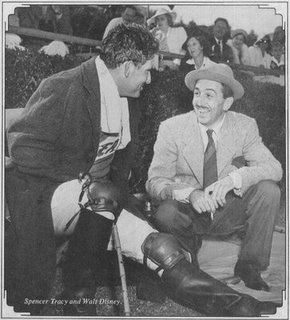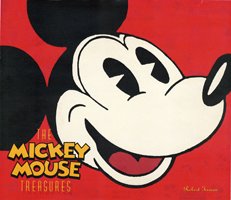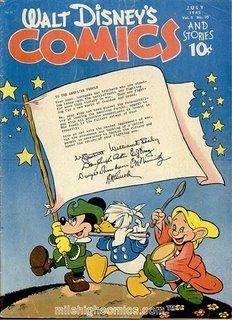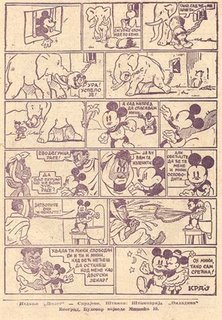
One more image from the mysterious Chicken Little project.
Interesting discoveries about Disney history, vintage Disneyana, Disney artwork, the Walt's People book series, and new books about Disney.


Here us the third part of Jim Korkis' great series about Walt and polo (yes, that is Walt on the right):
"In 1934, Roy Disney bought four polo ponies. At one point, Walt had over a dozen horses in his stable.
Walt was neither athletic nor coordinated. One Disney employee wondered aloud how Walt was able to stay on the horse and swing the mallet at the same time.
Unlike other young boys, Walt never played sports. For most of his childhood, he got up at three o'clock in the morning to deliver newspapers and then rush to school. At lunch time, he ran across the street to a local business to do errands and cleaning up in exchange for a hot lunch. After school, he would have to run home to deliver the evening edition of the newspaper and then come home to do homework, eat dinner and get ready for the routine to begin the next day.
Walt compensated for this lack of learning sports skills by being a focused competitor. Actor Robert Stack who was a teenager at the time remembered that Walt would "run right over anybody who crossed the line." At his home, Stack still has some trophies with Walt's name on it commemorating some of the matches they won while playing together.
Will Rogers was even more aggressive and lost a few fans with his attempts to hog the ball all the time.
However, by 1938, Roy Disney was becoming worried that the combination of Walt's aggressiveness and the inherent danger of the sport itself might rob the Disney Studio of its visionary. Walt resisted that suggestion to hang up his mallet even after he had been in two matches where fellow horsemen had suffered fatal injuries.
Always pushing himself, Walt eventually wanted to play with the better players. There was a South American team (known as "The Argentines") who were practicing on a field at the Riviera and Walt wanted to practice with them. Even then, it was almost impossible to tell Walt "no" so Walt took the field. One of the players hit the ball just as Walt on his horse was turning around and the ball hit Walt hard enough to knock him from the saddle.
Walt had four of his cervical vertebrae crushed and was in tremendous pain. Instead of seeing a doctor, he went to a chiropractor who manipulated Walt's back. Sadly, the injury might have healed if Walt had been placed in a cast. Instead, it resulted in a calcium deposit building up in the back of his neck that resulted in a painful form of arthritis that plagued Walt for the rest of his life.
In his later years, Walt required a couple of shots of scotch and a massage from the studio nurse in order to get home at night. When he went into St. Joseph's Hospital for the final time, it arose no suspicion when employees were told Walt was taking care of an "old polo injury".
Both Walt and Roy sold their polo ponies although Actor Fess "Davy Crockett" Parker has said that during one of the early parades at Disneyland, he and Walt rode on Walt's polo ponies resulting in the extremely tall Parker having his feet dangling over the side of the horse.
Believe it or not, the story continues tomorrow...."


As promised, here is the second part in Jim Korkis great 5-part series about Walt and polo:
"The popularity of Mickey Mouse in the early Thirties was a mixed blessing for Walt Disney. The stress of running and expanding his studio and the demands being made in other areas as varied as merchandising and publicity as well as stress at home with his wife Lillian suffering through two miscarriages drove Walt to one of his infamous breakdowns.
Walt's doctor suggested that Mickey Mouse's father take up some form of exercise to help relieve the stress. Walt tried wrestling, boxing and golf but each attempt only frustrated him further rather than releasing the tension. Walt had always loved horses and he took up horseback riding and joined a local riding club.
Walt was a great multi-tasker and it occurred to him that he could combine his love of horseback riding with his desire to integrate with Hollywood society by taking up the then highly popular port of polo.
Originally, Walt enlisted Jack Cutting, Norm Ferguson, Les Clark, Dick Lundy, Gunther Lessing, Bill Cottrell and even his brother Roy to participate. They studied the book "As To Polo" by Cameron and had lessons and lectures by Gil Proctor, a polo expert. Eventually, they did riding practice in the San Fernando Valley from six in the morning until they had to report to work at the Disney Studio at eight.
Walt even built a polo cage at the studio so that during lunch breaks, the men could sit on a wooden horse and practice hitting the wooden ball into a goal. Finally, they started participating in matches with similarly inexperienced teams at the stadium on Riverside Drive. Walt and Roy would play regularly with their employees on Wednesday mornings and Saturday afternoons.
In addition, Walt and Roy joined the prestigious Riviera Club where such Hollywood luminaries as Spencer Tracy, Leslie Howard, Darryl Zanuck and others held court on the playing field. Roy Disney was a fair player but Walt was highly aggressive.
One of the major players in these matches was Will Rogers. Walt liked the folksy humorist and had been in discussions with him to star in Walt's first full length animated feature film, "Rip Van Winkle".
"Snow White" was not the first choice of a feature project for Walt. He had developed several possibilities including "Alice in Wonderland" featuring a live action Mary Pickford interacting with animated characters. When that project fell apart, Walt considered using the same concept but with Will Rogers as Rip Van Winkle interacting with animated characters.
Disney historian J.B. Kaufman discovered that group of Disney animators including Art Babbitt, Grim Natwick and Bill Tytla had been taken to Will Rogers' ranch in Santa Monica to make sketches of the comedian in action. Although this session might have been for another Disney cartoon that never featured Will Rogers.
The story continues tomorrow..."


Here is a mystery for you!
A few years ago, I bought a series of drawings by Ken Anderson from Howard Lowery. They seem to be from a proposed short or featurette about Chicken Little.
Unfortunately the Disney Archives do not seem to have any record of this project and it is not mentioned in The Disney that Never Was. I will be posting other images of it this week. Some of them include Mickey, Goofy, Donald, Daisy and even Jiminy Cricket!
It looks as if it was created in the late '40s or early '50s.
Would any of you possess additional information on this strange project?

 If there is only one article you were to read this week about Disney animation, my strong advice would be to select The Secret Walt Disney Commercials by Jim Korkis. I had never, ever seen the subject discussed in so much detail before. Maybe it's just me, but dicsovering this great piece of Disney research this morning thanks to Cartoon Brew just gave me a quick.
If there is only one article you were to read this week about Disney animation, my strong advice would be to select The Secret Walt Disney Commercials by Jim Korkis. I had never, ever seen the subject discussed in so much detail before. Maybe it's just me, but dicsovering this great piece of Disney research this morning thanks to Cartoon Brew just gave me a quick.




 Here are the remaining images about Walt and polo, as sent by David Lesjak. Speaking of whom: David just posted a new interesting article on the Toons at War blog.
Here are the remaining images about Walt and polo, as sent by David Lesjak. Speaking of whom: David just posted a new interesting article on the Toons at War blog.

Ok, this is clearly not Disney related, but I will give myself the right to post some things about Warner on this blog on an exceptional basis if they focus on the Golden Age of animation.
Here is a post that has appeared last week on the ASIFA Animation Archive site. I really hope that one of the readers of the Disney History blog will be able to help (please do let me know if you were to contact Steve as I would also really love to read those transcripts).
"Reg Hartt in Canada was kind enough to send us CDs of over 8 hours of interviews with Bob Clampett where he discusses his entire career. We need volunteers to transcribe the interviews to text files. The audio quality is a bit dodgy, so it's going to take some careful listening with headphones to transcribe everything. This is a project that could be done anywhere in the world by email. If you have some time available, and would like to help out, email me at sworth@animationarchive.org."

 You know it's definitely a special day when you discover on ebay two David Hall concept paintings you had never seen before and countless others by Mary Blair. If you are a serious Disney art lover, checkout the auction organized by Morphy Auctions on ebay to understand my excitment.
You know it's definitely a special day when you discover on ebay two David Hall concept paintings you had never seen before and countless others by Mary Blair. If you are a serious Disney art lover, checkout the auction organized by Morphy Auctions on ebay to understand my excitment.


Got the following email from Dennis Books yesterday about my post from a few days ago about Walt Disney’s Comics and Stories # 58, July 1945:
"I have attached a copy of a poster (1939 assumed by copyright) found with other items, all dating to the early '30s in old motion picture house files. The background pictures scenes from American conflicts. Here Willard's painting is featured with Disney's."
 The Walt Disney Family Museum site was updated today with three great articles about El Grupo's trip to South America in 1941 (above a concept drawing of the Sugar Loaf in Rio de Janeiro by Mary Blair). As if I did not miss living in Brazil enough already!!
The Walt Disney Family Museum site was updated today with three great articles about El Grupo's trip to South America in 1941 (above a concept drawing of the Sugar Loaf in Rio de Janeiro by Mary Blair). As if I did not miss living in Brazil enough already!!


This just in from David Lesjak:
"Hello Didier.
As you know, I have been collecting vintage Disneyana
since about 1981. I particularly like early paper items. I had time tonight to scan some rather esoteric items from my collection, which I’d like to share with you and those who read your blog. According to Bob Thomas’ book – Walt Disney An American Original – Walt Disney began playing polo in 1932. Walt kept a stable of ponies at the Riviera
Country Club. Here are two interesting trivia questions: what were the names of Walt Disney’s polo ponies and what number did Walt wear on his game jersey?
Walt was able to convince several Studio employees to
be on his polo team including: his brother Roy, Les Clark, Norm Ferguson, Jack Cutting, Dick Lundy, Bill Cottrell and Gunther Lessing. I also believe Dave Hand (Supervising Director, Snow White and the Seven Dwarfs also played). By all accounts Walt loved the game and the social interaction. Disney played as often as time would permit in those early days, taking on the likes of Spencer Tracy, Will Rogers, Darryl F. Zanuck, and James Gleason.
Walt eventually quit the game on the advice of his brother Roy. Walt was too valuable to the organization to be playing such a potentially hazardous game.
As a sidenote, Walt did suffer a serious injury, damaging several vertabrae after a fall. The injury caused him chronic pain in later years.
Anyhow, here are the answers to the trivia questions: according to an inventory list for Walt’s stable at the Riviera Country Club the ponies were called June, Slim, Nava, Arrow, Pardner, Tacky and Tommy. The answer to the second question? Walt wore the number 4 on his jersey."
I will post the other 3 photos that David sent within the next few days and also hope to get Jim Korkis to write a short article for the blog in the same subject.

I spoke with French author Pierre Lambert yesterday who mentioned that his next art book Walt Disney, l'Age d'Or should be released in France within the next few weeks in time for the launch of the prestigious Disney exhibit that will happen at Le Grand Palais starting on September 14 this year (more about this in a few weeks).
This is obviously exciting news, as Pierre Lambert's art books through their quality and sheer size have been favorites of Disney art enthusiasts for years. If you love fantastic Disney artwork and do not yet own his Pinocchio, Snow White and Mickey books, you are really missing something. They are very expensive, but one understands why when one sees them.

 Speaking of comics, here is a great email I received yesterday from Are Myklebust:
Speaking of comics, here is a great email I received yesterday from Are Myklebust:
Two nice articles to start the day, both written by my friend Jim Korkis, both from the Animation World Network: An interview with Floyd Gottfredson and The secret cartoon life of animators.

A few years ago I wrote "a history of Disney comics in former-Yugoslavia before WWII" for Tomart's Disneyana (issues 44 and 48). I have decided to start posting on this blog scans of all the locally created Serbian Disney stories that can be found in the Serbian comics magazines I own. I will post one each day for your enjoyment. One thing though: don't ask me to translate.
Here is a one page gag that was released in Mali Roman u Stripu number 1.

This weekend I was working on an interview of composer Buddy Baker by Jon Burlingame for Walt's People - Volume 5 and found this small story about fellow-composer Oliver Wallace that I thought you might enjoy:
"Ollie was a real character, a natural character. He would do funny things and he liked to play jokes on people. He had a great sense of humor. I remember one time I could hear him working, playing something over and over on the piano. I just copied it down and kept it for a couple of weeks. Ollie said to me one day, "You know, kid, if you get any ideas, let me hear them because I'm running out of ideas." So I waited until he said that to me the next time and I took this thing in and put it out there. I said, "Ollie, I came up with this. I thought it was okay." Then he played me some of the music. He got into it about six bars, then he turned around to me and said, "You son of a bitch!" [Laughter]"

David Lesjak is one of the few worldwide experts on the history of Disney during WWII (the only other historian I can think of that tackled the subject in-depth is Richard Shale - that is until Paul F. Anderson releases his special issue of POV on the subject).
A few years ago he published a small book called Toons at War that he is in the process of updating.
So you can imagine how delighted I was to get an email from him this weekend informing me that he had just launched his blog, Toons at War. My, as if I didn't have enough great blogs to check daily already. Oh well, there is nothing that I love more that great Disney research done by serious Disney historians.
 A great way to start the day this morning, if you have not already done so, is to check the 20 photos from the collections of Ray Aragon that Amid Amidi posted on Flickr this weekend and that depict life at the Disney Studio in the '50s.
A great way to start the day this morning, if you have not already done so, is to check the 20 photos from the collections of Ray Aragon that Amid Amidi posted on Flickr this weekend and that depict life at the Disney Studio in the '50s.

While checking which sites had decided to link to the Disney History blog, I stumbled upon the Stuff from the Park blog, which I had never seen before and that I highly recommend to fans of Disneyland history.
Here, a photo of Walt with one of the executives from the Van Camp tuna company in the Chicken of the Sea Pirate Ship restaurant, from a posting from May 20, 2006.
 Howard Lowery recently sold on ebay a series of beautiful storyboard drawings from Pilgrim Mickey. Aside from concept art, my other passion in terms of animation art are drawings from never-released Disney projects. It will therefore not come as a surpise that one of my "bibles" is Charles Solomon's book The Disney that Never Was.
Howard Lowery recently sold on ebay a series of beautiful storyboard drawings from Pilgrim Mickey. Aside from concept art, my other passion in terms of animation art are drawings from never-released Disney projects. It will therefore not come as a surpise that one of my "bibles" is Charles Solomon's book The Disney that Never Was.